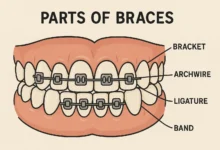Braces on Crooked Teeth Before and After: Real Results

Braces on Crooked Teeth: A Complete Guide to Straightening Your Smile
Introduction
The improper alignment of teeth creates obstacles for speech production and chewing ability and dental jaw health and leads to self-esteem problems. Orthodontics provides an effective solution for this condition. Orthodontics uses braces as one of the most popular and successful treatments for teeth alignment.
The education about braces and their types and treatment expectations should reach all people regardless of their age group. The following article provides a comprehensive guide about using braces for crooked teeth and how successful orthodontic treatment can change both your smile and your life.
1. What Are Crooked Teeth?
Teeth that grow at improper angles or in the wrong positions are known as malaligned or misaligned teeth. The teeth can be twisted, overlapping, spaced too far apart, or crowded together.
Common Signs of Crooked Teeth:

Overlapping teeth
Twisting or rotation
Teeth angled forward or backward
Overcrowding
Gaps between teeth
Misaligned jaw or bite
Putting braces on crooked teeth is one of the most reliable and efficient ways to correct these issues and achieve a healthier smile.
2. Causes of Crooked Teeth
Understanding the root causes of crooked teeth can help in prevention and treatment planning.
Common Causes Include:
Genetics: Inherited traits such as jaw size, tooth shape, or crowding tendencies
Thumb sucking or pacifier use: Especially after age 3
Tongue thrusting: Pushing the tongue against the teeth while swallowing
Premature loss of baby teeth: Leading to shifting of remaining teeth
Poor dental habits: Like mouth breathing
Trauma or injury: Damage to teeth or jaw can cause misalignment
The correction of most alignment problems becomes possible through braces on crooked teeth regardless of the initial cause when treatment begins early or continues into adulthood.
3. Why Get Braces on Crooked Teeth?

Straightening your teeth is about more than just appearances. Crooked teeth can lead to several health and functional issues.
Health Benefits:
Improved oral hygiene: Easier to brush and floss
Better digestion: More efficient chewing
Reduced risk of gum disease and cavities
Alleviated jaw pain or TMJ issues
Reduced wear and tear on enamel
Emotional and Social Benefits:
Boosted self-confidence
Better speech clarity
Improved social and professional interactions
Getting braces on crooked teeth is an investment in both your health and self-esteem.
4. How Braces Work to Straighten Crooked Teeth

Braces work by using brackets and wires and bands to deliver constant gentle pressure that shifts your teeth into correct positions.
Process:
Brackets are bonded to each tooth
An archwire is connected to the brackets
Elastics or ligatures hold the wire in place
The wire is adjusted over time to guide tooth movement
Orthodontists design treatment plans based on the extent and configuration of the malocclusion to ensure optimal remediation via the application of mechanical forces.
5. Types of Braces for Crooked Teeth
There are several options for patients who need braces on crooked teeth, each with its pros and cons.
1. Metal Braces
Most common and effective
Highly visible but durable
Suitable for all levels of misalignment
2. Ceramic Braces
Tooth-colored brackets for a discreet look
More fragile than metal
Ideal for mild to moderate crookedness
3. Lingual Braces
Attached to the back of teeth (invisible)
Harder to clean, may cause tongue discomfort
Suitable for patients needing subtle treatment
4. Clear Aligners (e.g., Invisalign)
Removable trays made from clear plastic
Best for mild to moderate cases
Requires discipline (20–22 hours/day wear)
Consult your orthodontist to determine which type of braces on crooked teeth is best for your specific case.
6. Braces on Mild vs. Severe Crooked Teeth
The extent of tooth misalignment determines the complexity and duration of treatment.
Mild Crookedness:
One or two misaligned teeth
Shorter treatment time (6–12 months)
Often correctable with clear aligners or partial braces
Moderate to Severe Crookedness:
Multiple overlapping or twisted teeth
Longer treatment time (12–30 months)
May require extractions or jaw expansion
Severe cases benefit the most from traditional braces on crooked teeth, offering precise control and customization.
7. Treatment Timeline: How Long Do Braces Take?
There’s no one-size-fits-all answer. Treatment length varies based on the complexity of your case and your compliance.
Average Timeframes:
Mild cases: 6–12 months
Moderate cases: 12–18 months
Severe cases: 18–36 months
Regular adjustments and good oral hygiene can help reduce treatment time for braces on crooked teeth.
8. Braces on Crooked Teeth: Step-by-Step Process
Step 1: Initial Consultation
Dental exam, X-rays, and treatment plan
Step 2: Braces Placement
Brackets are bonded, wires inserted, and elastics placed
Step 3: Regular Adjustments
Monthly visits to tighten or adjust wires
Step 4: Monitoring Progress
Gradual movement of teeth, real-time tracking
Step 5: Removal
Braces removed after alignment is achieved
Step 6: Retainers
Worn to prevent teeth from shifting back
The process of placing braces on crooked teeth is straightforward and well-established, with high success rates.
9. Cost of Braces for Crooked Teeth
Cost varies based on treatment type, location, and complexity.
General Cost Range:
Metal Braces: $3,000 – $7,000
Ceramic Braces: $4,000 – $8,000
Lingual Braces: $8,000 – $12,000
Clear Aligners: $3,500 – $8,000
The costs associated with mild cases of misaligned teeth are more affordable; however, more severe cases increase the cost of treatment due to lengthier time and additional materials required.
10. Insurance and Financing Options
Most dental insurance plans cover part of the cost of orthodontic treatment.
Tips to Save:
Choose an orthodontist in your insurance network
Use FSA or HSA accounts for tax-free payments
Ask about in-house monthly payment plans
Look for dental discount programs or community clinics
Financial planning is key when considering braces on crooked teeth, especially for families or adult patients.
11. Pain and Discomfort: What to Expect
Discomfort is common during the first few days after getting braces and following adjustments.
Common Symptoms:
Soreness in teeth and jaws
Irritation on cheeks and lips
Difficulty chewing
Remedies:
Over-the-counter pain relievers
Orthodontic wax to protect soft tissue
Soft foods like soup, yogurt, and mashed potatoes
Most patients adjust within a week of getting braces on crooked teeth.
12. Caring for Braces on Crooked Teeth

Proper care ensures smooth treatment and prevents complications.
Daily Oral Care:
Brush after every meal using a soft-bristle toothbrush
Floss with a floss threader or water flosser
Use fluoride mouthwash
Foods to Avoid:
Sticky foods (gum, caramel)
Hard foods (nuts, popcorn, ice)
Sugary snacks that increase risk of decay
By protecting your braces on crooked teeth, you help ensure faster and more effective results.
13. Before and After: Real Results from Braces
The transformation from crooked to straight teeth can be dramatic.
Realistic Results:
Aligned and evenly spaced teeth
Corrected bite (overbite, underbite, crossbite)
Enhanced facial symmetry
Improved speech and chewing function
The orthodontic treatment of misaligned teeth leads to aesthetic improvements and simultaneously enhances both psychological and structural functionality.
14. Alternatives to Braces for Crooked Teeth

While braces remain the gold standard, some alternatives exist for specific cases.
1. Clear Aligners (e.g., Invisalign)
Great for adults with minor alignment issues
2. Veneers
Cosmetic solution that masks crooked teeth
Does not fix alignment or bite
3. Palatal Expanders
Used in children to widen the jaw before braces
For most patients, braces are the most effective and enduring solution compared to other alternatives which may seem to have an appeal.
15. Final Thoughts: Are Braces Worth It?
Fitting braces on misaligned teeth is one of the most beneficial steps to take regarding your long-term oral health, aesthetics, and self-esteem.
Key Benefits:
Improved function and oral hygiene
Long-term dental stability
Confidence in personal and professional settings
Braces serve as a dependable solution to enhance your smile when you are either a parent who needs to choose treatment options for your child or an adult who wants to fix existing alignment problems.
Can You Eat Skittles with Braces? The Sweet Truth You Must Know








